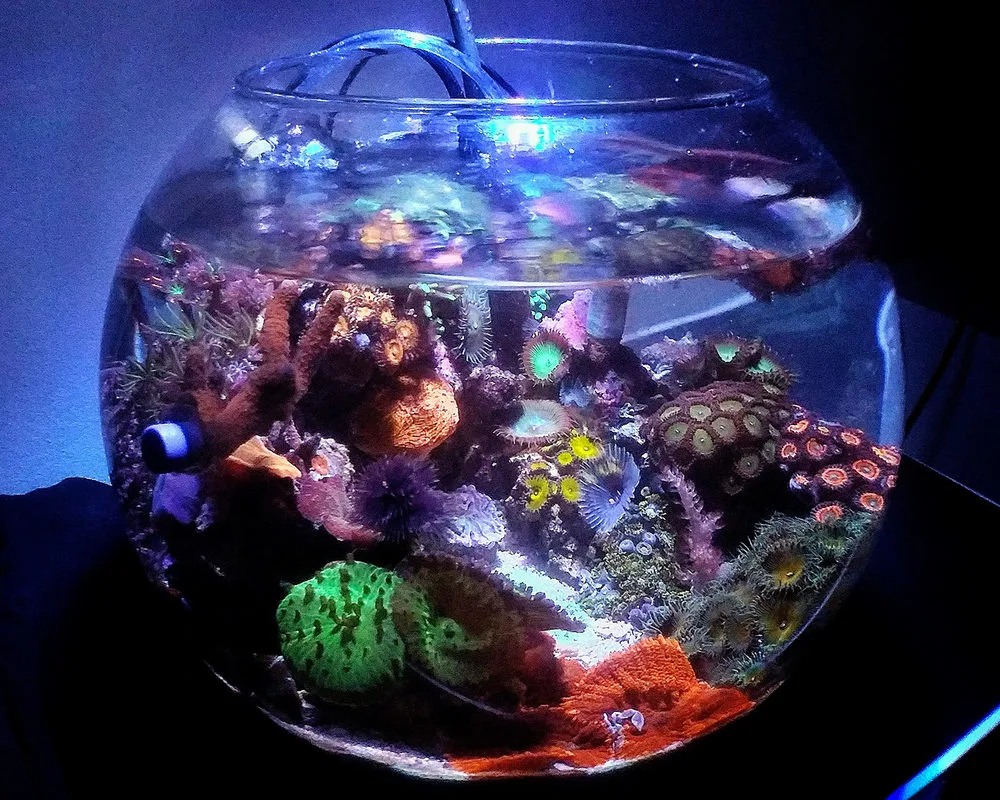Stunning 3-Gallon Reef Tank – TheRope's TOTM | NanoReef

Tank Specifications
Volume: 3 Gallons / 11 Liters
Dimensions (L × W × H):
10.0" ×
10.0" ×
9.0"
25.4cm ×
25.4cm ×
22.9cm
Equipment List
- Salt: Red Sea
Frequently Asked Questions
What is your water change schedule and how do you perform it?
I perform water changes weekly, aiming for at least 50% but usually closer to 90%. I use store-bought distilled water mixed with RedSea Coral Pro salt, ensuring the right temperature and salinity before adding it to the tank.
How do you feed your corals and invertebrates?
I feed a small amount of ReefRoids along with a few drops of Seachem phytoplankton. Additionally, I spot feed my LPS corals with pellets. This feeding occurs about 3 to 4 times a week, ensuring my feather worms receive nutrients as well.
How do you manage evaporation and top-off water?
I typically top off for evaporation once a week. I draw a line on the bowl after every water change to monitor the water level. When I observe evaporation, I simply raise the water level back to that line.
What do you do about waste buildup and skimming?
I use air bubbles from the air pump for water circulation, which acts as a form of surface skimming. Any waste that collects above the water line is wiped down during water changes.
How do you monitor the water quality in your reef bowl?
I primarily check salinity and temperature. I test salinity weekly with an ABI refractometer right after doing a water change, and I monitor the temperature using a digital controller.
Do you test your water parameters frequently?
I do not engage in extensive testing; I focus more on observing my corals for signs of health. I believe that testing can often yield misleading results due to nutrient consumption in the tank.
What type of corals do you keep, and how do you manage them in a small tank?
I keep a variety of soft corals, LPS corals, and some SPS corals. In such a small space, I prefer soft corals for their hardiness and compatibility with other types. They fill the space well and are easier to manage in a 3-gallon setup.
How do you handle potential emergencies, like a decaying coral?
In case of emergencies, like the recent incident with a decaying Coco Worm, I immediately remove the affected coral and perform daily 100% water changes for several days. This quick action helps restore water quality and coral health rapidly.
What advice do you have for new reef tank enthusiasts?
My key advice is not to chase ideal parameter numbers as they vary from tank to tank. Observe your corals closely; they will be your best indicators of health. Accurate readings can sometimes be misleading due to natural consumption of nutrients by the tank's inhabitants.
What is your philosophy on feeding in pico reef tanks?
In a pico reef tank, you don't need to feed as frequently as I do. Often, one feeding before a water change per week or every two weeks is sufficient unless you have heavy feeders like feather worms.